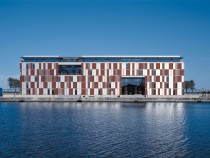
© Adam Mørk
Although office developments usually consist of a banal succession of repetitive working spaces, many administration buildings have achieved world renown, from the Chrysler Building by William Van Alen to the Hong Kong & Shanghai Bank by Norman Foster. Office structures may be speculative schemes built by investors to be rented out, or client-occupied developments. In the former case, the user(s) may not be known at the design stage, so that it will be necessary to incorporate some flexibility to allow for different sized units and subsequent changes of tenants; and when a yield is expected on investments, the construction costs will inevitably be restricted. Where buildings are to be occupied by the client, the design can be tailored to the specific needs of users and corporate identity. Planners go to great lengths today to create congenial working conditions with individual control of the indoor environment; and great importance is attached to communication. An optimum exploitation of daylight, and energy-saving concepts have become essential aspects of modern office design. Although expectations still vary internationally, even in countries with access to cheap oil there is a growing awareness that high energy consumption can amount to a second office rent. (Frank Kaltenbach)










